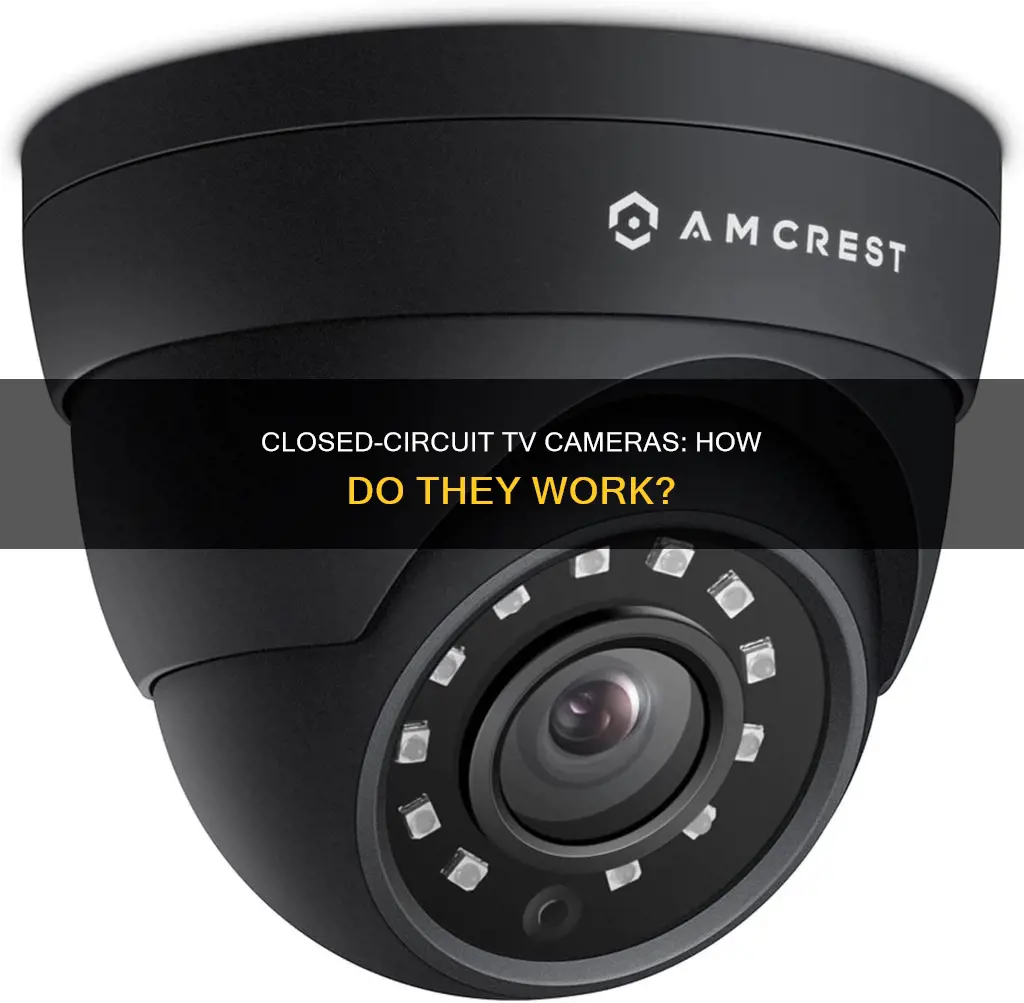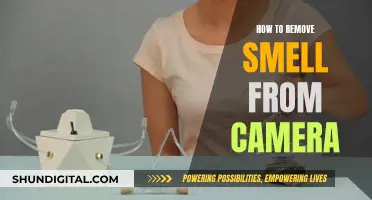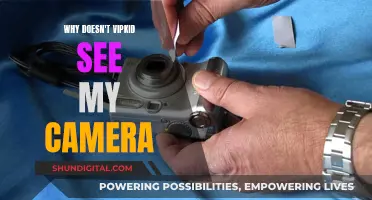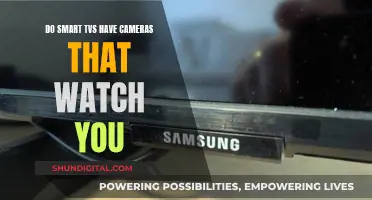
Closed-circuit television (CCTV) is a system that uses strategically placed cameras to transmit video to a limited set of monitors. Unlike broadcast television, CCTV does not publicly distribute its signal but instead communicates across a private cable run or wireless communication link. This restricted access to data transmissions is what gives the system its closed-circuit designation.
CCTV is commonly used for security and surveillance purposes, such as maintaining perimeter security, observing behaviour in medical facilities, and overseeing locations that are hazardous to humans.
| Characteristics | Values |
|---|---|
| Definition | Closed-circuit television (CCTV) |
| Type of System | Closed-loop system |
| Signal Transmission | Between set points decided by the camera's owner or operator |
| Use | Surveillance and security |
| Camera Placement | Strategic |
| Camera Operation | Remote control or fixed sight line |
| Camera Design | Half-sphere design providing 360-degree view |
| Camera Mounting | Body-mounted or fixed on walls or above doors |
| Display Devices | Monitors |
| Data Networks | Wired or wireless |
| Camera Types | Analog, digital (IP), IP-based network, wireless, web security, WDR security, infrared, etc. |
| Recording Devices | DVRs (digital video recorders) and NVRs (network video recorders) |
| Power Sources | Grid or monitor |
| Alert Types | Real-time alarms and notifications |
What You'll Learn
- Closed-circuit television (CCTV) is a closed-loop system
- CCTV cameras are fixed on walls, above doors, or body-mounted
- CCTV systems consist of video cameras, display devices, and wired or wireless data networks
- CCTV is used for security and surveillance purposes
- CCTV systems can be integrated with security systems and other information systems

Closed-circuit television (CCTV) is a closed-loop system
The system typically includes video cameras, display devices (monitors), and wired or wireless data networks. The data networks can be wireless communication links or a proprietary coaxial cable run. Access to data transmissions is limited by design. The system may also include other devices such as servers, disk storages, and client computers that allow for the storage and processing of video data.
CCTV is primarily used for surveillance and security purposes. The cameras are often fixed on walls or above doors and may be operated by remote control, or have a fixed sight line. The footage can be viewed live and also archived for later review.
CCTV has been used for decades, with one of the earliest mechanical systems being developed in 1927 by Russian physicist Léon Theremin. Since then, the technology has advanced significantly, with modern CCTV systems offering high-resolution colour displays and features such as motion detection, email alerts, and the ability to zoom in or track objects.
Everly's Camera: A Watchful Eye
You may want to see also

CCTV cameras are fixed on walls, above doors, or body-mounted
Closed-circuit television (CCTV) is a surveillance system where signals are monitored privately and are not publicly distributed. The system is called "closed-circuit" because the cameras, monitors, and video recorders communicate across a private cable run or wireless communication link.
CCTV cameras are often fixed on walls or above doors, and can also be body-mounted. When installing a CCTV camera, it is important to consider its purpose and the area it needs to cover. Here are some tips for fixing CCTV cameras:
- For optimal security, it is recommended to place cameras at a height of 9 to 10 feet to prevent tampering. This height also provides a wider angle of view and can be achieved by mounting the camera on a wall or ceiling.
- Cameras should be placed in a corner of the room opposite the entry point. This ensures that anyone attempting to tamper with the camera is recorded first.
- For outdoor cameras, it is preferable to mount them on the side of a building rather than directly on the roof, as this provides some shelter from harsh weather conditions.
- To avoid blind spots, consider using multiple cameras. For example, placing two cameras back-to-back on a wall can eliminate blind spots.
- When using multiple cameras, ensure they are placed strategically to cover the desired area effectively. For instance, the "Secret Service Pattern" involves installing two cameras on the same wall, separated by 15-20 feet and aimed at each other, ensuring that neither camera can be disabled without the perpetrator being recorded.
- Consider the lighting conditions, as direct sunlight or bright lights can disrupt the picture quality. Additionally, avoid aiming cameras at large exterior windows, as the view may be limited during bright or sunny days due to auto-iris adjustments.
- If you want to monitor a specific object or person, ensure the camera's field of view is appropriate for the distance and angle required. A 2.8mm lens, for instance, provides a viewing angle of 110 degrees and is suitable for up-close monitoring, such as on a porch.
- For indoor surveillance, consider using the "trap surveillance pattern", which involves strategically placing cameras in corners of the home to create a cost-effective form of indoor surveillance. This design ensures that individuals cannot move from one area to another without being recorded, while also keeping private areas such as bedrooms and bathrooms unmonitored.
- To monitor a large area, consider using pan-tilt-zoom (PTZ) cameras, which offer a remote directional and optical zoom capability.
- For body-mounted CCTV cameras, consider the size and weight of the camera to ensure comfort and ease of movement for the wearer.
Accessing ADT Cameras: Server Viewing Guide
You may want to see also

CCTV systems consist of video cameras, display devices, and wired or wireless data networks
Closed-circuit television (CCTV) systems are used for surveillance and security purposes. They are commonly used in areas that require additional security or ongoing monitoring. CCTV systems consist of video cameras, display devices, and wired or wireless data networks.
CCTV cameras can be categorised into two types: Internet Protocol (IP) or analog. IP cameras are usually preferred due to their compatibility with most devices. Various types of cameras can be installed, such as dome cameras, bullet cameras, and covert cameras. The choice of camera depends on factors such as the number of angles to be covered, the desired resolution, and the specific area being monitored.
The display devices in a CCTV system are the monitors that allow users to view recorded images and footage. The number of monitors required depends on the size and scope of the area being monitored. For large-scale facilities, three to five screens may be necessary. Wired systems use coax cables to connect the cameras to the monitors, while wireless systems require routers to transmit data.
CCTV systems also include video recorders, such as DVR (Digital Video Recorders) and NVR (Network Video Recorders), which process and store the video data. These recorders enable users to archive footage for later use, which is particularly useful for authorities investigating criminal activity.
The data networks in a CCTV system can be wired or wireless. Wired networks use coaxial cables to transmit data, while wireless networks use links such as point-to-point, point-to-multipoint, or mesh connections. The choice between wired and wireless networks depends on factors such as the desired level of security, ease of installation, and cost.
The Camera's Eye: Passive Observer or Active Participant?
You may want to see also

CCTV is used for security and surveillance purposes
Closed-circuit television (CCTV) is a system in which all elements, from the cameras to the recording devices, are directly connected to keep the video from being broadcast over public airwaves. It is used for security and surveillance purposes in a variety of settings, including:
Homes and Residential Areas
CCTV cameras are often installed outside or inside homes to deter potential intruders and reduce the chances of burglaries and vandalism. They can also be used as "nanny-cams" to monitor household staff and ensure children are in good hands.
Businesses and Public Spaces
CCTV is commonly used in businesses such as banks, offices, museums, restaurants, and retail stores to prevent crimes such as theft and vandalism. They are strategically placed at registers, back offices, near safes, and entrances. In public spaces, CCTV cameras help monitor traffic, detect congestion, and identify accidents. They are also used in schools to prevent bullying and vandalism and to monitor visitors.
Industrial and Restricted Areas
CCTV equipment is useful for observing industrial processes from a central control room, especially in dangerous or inaccessible environments. They can also be used to monitor areas that are not easily accessible, such as rooftops.
Law Enforcement and Emergency Services
Law enforcement agencies use CCTV to monitor traffic and identify traffic violations. The footage helps identify and penalize reckless drivers. Additionally, CCTV cameras aid in real-time assessment and monitoring of emergency situations, providing valuable information to disaster management teams.
Medical Monitoring
CCTV cameras can be used to monitor patients, especially children or the elderly, and detect potential medical emergencies such as strokes, epileptic seizures, or asthma attacks.
Research and Analytics
CCTV footage is used by researchers to study crowd activities and prevent anti-social behaviors. It is also valuable for market research, as it helps analyze buying trends and shopper behavior, enabling businesses to enhance their strategies.
The Art of Cinematography: Masterful Camera Control
You may want to see also

CCTV systems can be integrated with security systems and other information systems
Closed-circuit television (CCTV) is a TV system where signals are transmitted to a specific place on a limited set of monitors, instead of being publicly distributed. It is primarily used for surveillance and security purposes. CCTV systems can be integrated with other security systems and information systems in various ways.
One example of this integration is with access control systems. By combining CCTV with access control, emergency response capabilities are improved. For instance, if unauthorized access occurs at one access point, security personnel can use the CCTV system to quickly gather more details about the situation. This integration also allows for centralized management of a facility's security, streamlining the process of gathering security information. Furthermore, open-architecture technologies used in this integration enable easy system upgrades in the future. Physical Security Information Management (PSIM) software is a crucial tool that facilitates the integration of multiple systems, including CCTV, access control, and panic alarms, onto a single platform. This centralized management enhances efficiency by reducing the time spent on installing and sorting through decentralized security data.
CCTV systems can also be integrated with monitoring devices, alarm systems, and access control devices. This integration assists security personnel in identifying and interrupting security breaches as they occur or even before they take place. Intelligent video algorithms, such as motion detection and object recognition, play a vital role in this process. For instance, these algorithms can detect unusual walking patterns or identify a briefcase left in a suspicious location, alerting security guards to take appropriate action.
In addition to security systems, CCTV can be integrated with other information systems. For instance, in industrial plants, CCTV equipment may be connected to a central control room to observe processes, especially in areas that are dangerous or inaccessible to humans. This integration enhances safety by providing remote monitoring capabilities.
Ranged Attack Camera in Medieval Total War: Ultimate Viewing Guide
You may want to see also
Frequently asked questions
A closed-circuit TV camera is part of a closed-circuit television (CCTV) system, which is a closed-loop system that transmits television signals to a specific, limited set of monitors. Unlike broadcast television, the signals are not publicly distributed but are monitored for security and surveillance purposes.
Closed-circuit TV cameras work by transmitting video signals to a specific place or set of monitors. The system can be wired or wireless and often includes cameras, monitors, servers, and storage devices. The footage can be viewed in real-time and archived for later use.
Closed-circuit TV cameras are commonly used for security and surveillance purposes to deter and prevent crimes, particularly in areas that require additional security or ongoing monitoring. They can also be used to observe industrial processes, ensure perimeter security, and obtain a visual record of human activity.
Closed-circuit TV cameras are typically used in public spaces, industrial plants, retail stores, banks, schools, and residential areas. They can be fixed on walls or above doors and may be operated by remote control or have a fixed sightline.







